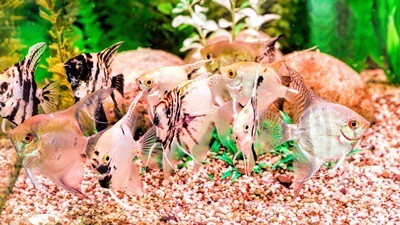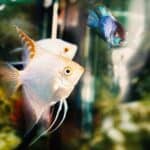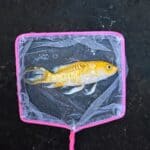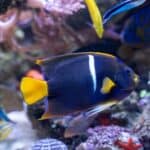Angelfish can be riled by too much activity in the tank, overcrowding, or poor water conditions. They get stressed out when they don’t have enough hiding places and aren’t properly fed.
When angelfish are stressed, they tend to be more aggressive, swim at frantic speeds, and hide themselves away for long periods.
They may begin ‘surfing the glass,’ swimming up and down against the tank for hours.
Angelfish ill from the stress may lose their appetite and change in appearance. They’ll be more prone to sicknesses, display fin rot, and have dimmer colors.
The best way to treat a stressed angelfish is to calm its environment. This includes changing the water, checking the pH level, placing an oxygen pump in the tank, and treating illnesses.
If angelfish are stressed by activity, remove aggressive fish from the tank or reduce the population.
Is My Angelfish Stressed?
Angelfish can get overwhelmed and stressed.
Sure, they’re contained in a tank and don’t interact with the rest of your home. However, there are still annoyances, scary situations, and environmental changes that will upset your angelfish.
The stressors that angelfish experience are placed in two categories:
- Environmental stressors: These are due to the tank setup or how you adjust the water parameters.
- Social stressors: These are caused by other fish or the territory established within the aquarium.
If the tank occupants are exposed to even one stressor, they can grow ill over time. If they’re exposed to several or a combination of both, the issue will quickly snowball.
No matter the stressor, you can resolve the problem. The likely causes include:
Improper Water Conditions
The water conditions in the tank are the angelfish’s entire world. According to ILAR Journal, if even one factor is slightly off, the angelfish may:
- Suffocate.
- Freeze or overheat.
- Struggle to process nutrients.
- Feel anxious or threatened.
- Struggle to recoup energy.
- Be unable to mate or reproduce.
This will unbalance how your angelfish lives, interacts, and thrives in the tank. You’ll observe angelfish in poor water quality, growing ill or aggressive.
If you notice a sudden behavior change, angelfish gasping at the surface, or lethargy in the tank occupants, immediately conduct a water test. The main issues to look for include:
- A low or high pH level.
- Improper temperature.
- High nitrate or ammonia levels.
- Low oxygen levels can lead to stress.
- Imperfect salt levels in a saltwater tank.
Problems With Other Fish
Angelfish are social creatures but are also territorial. This can cause a range of stressors if you populate the tank carelessly. Angelfish become stressed if:
- They’re kept alone in a tank.
- They’re only given a single companion and can’t school.
- There are too many fish in the tank.
- The tank holds an unsuitable combination of fish.
Angelfish shouldn’t be kept alone, as they’ll become restless and lonely. If they’re only given a single companion, some angelfish will be okay, while others will still feel isolated.
Conversely, angelfish require space to carve out their territory.
If they feel crowded by too many other fish, be they angels or another species, they can get defensive. As they try to protect their mate and zone, they can become overworked and stressed.
If angelfish are paired with incompatible species, this can lead to fighting.
At the least, the angels will eat other fish that can fit into their mouths. They may also harass larger fish incessantly, killing them or exhausting themselves.
Angelfish may get bullied by other fish and feel constantly threatened. The constant need to fight, run, or hide can wear down their immune system and energy.
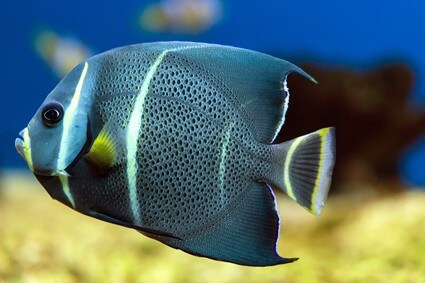
Diet
According to Aquaculture International, diet impacts how resistant angelfish are to stress. When they’re given food high in vitamins C, E, and K, they can adapt to subpar conditions.
Angelfish are omnivorous, but they require a high amount of protein in their diet. This means they need fish food, frozen food, live food, and freeze-dried food, which leads to a carnivorous diet.
If you don’t provide the right amount of protein, the fish will become stressed. The lack of nutrition will leave them lethargic, aggressive, and unbalanced.
Angelfish don’t react well to food shortages. Overcrowding causes food competition, and being housed with aggressive fish leads to starvation.
Temperature
The temperature of the water plays a vital role in the immune system of angelfish.
They can tolerate water conditions slightly outside of their preferred zone. However, if the difference is too stark, they may grow stressed and ill.
For example, temperatures far above or below 78- 84 Fahrenheit can cause their immune system to weaken. This can lead to diseases, infections, and stress, lowering their defenses further.
Dirty Water
Even if the tank is ideally set up and the population is balanced, the waste can build up.
If the filter has broken down without you realizing it, or you haven’t changed the water recently, the fish will grow stressed.
They’ll swim and breathe the filth, as well as tolerate the change in the chemical balance. Even forgetting to change the tank water for a week can lead to angelfish manifesting symptoms of stress.
Lack Of Aquarium Décor
Angelfish need space to explore, but that doesn’t mean leaving the tank empty. Hiding places should be placed throughout to ensure the angelfish have:
- Places to set up territories.
- Places to hide from other fish.
- Objects that break the line of sight so the angelfish don’t feel crowded.
- Items to lay eggs on or interact with.
The substrate type is also essential. For instance, using stone and gravel allows good bacteria to accumulate and maintain healthy nitrogen levels.
Natural plants can assist in stabilizing the CO2 and nitrogen levels.
Signs of Stress in Angelfish
Angelfish can’t rely on the vast expanse of an ocean or river to give them distance from their stressors. They have no control over what they can eat or what their environment is like.
If left unattended, the angelfish may not recover. Identify and resolve the problem as soon as possible.
Check for these angelfish stress symptoms that can warn you ahead of time:
Glass Surfing
Angelfish may revert to their instincts when stressed and try to escape.
As they swim away, they’ll hit the glass and be forced to swim along it. This results in “glass surfing.” The fish will swim from the top to the bottom of the aquarium walls several times.
They may do this for hours as if trying to find a nook. Angelfish do this when they:
- Feel overcrowded and want to get distance.
- Attempt to flee from a predator in their area but aren’t being actively pursued.
- Are unsettled by a temperature imbalance and want a hotter or cooler spot.
Excessive Hiding
When new angelfish are introduced to the tank, it’s normal for them to hide in the initial few hours.
This may even last for a day or two. Angelfish that are comfortable in the tank may hide as they recoup energy, feel threatened, or protect eggs.
It’s a bad sign if the angelfish hides almost constantly. If you don’t see it emerge for several days, or it only comes out to feed, this is a symptom of stress.
The angelfish aren’t simply winding down or taking a break from the other fish. Instead, they’re too afraid to emerge and feel constantly threatened by their environment.
If only one fish is doing this, it could mean it’s:
- Sick.
- Injured.
- Being bullied.
- Feels overcrowded.
If several fish do this, something is amiss with the water conditions. They may also struggle with too much light exposure or activity outside the tank.
Changes In Appearance
If the stress goes on long-term, the angelfish may show damage from the stress. This can include:
- Dimmer colors that appear dull and lifeless.
- Stripes that fade away or appear faded in color.
- Scales that appear flaky or frail.
- Fins that seem ashy or thin.
This will be prominent among angelfish that were bright and colorful before.
This happens to fish stressed by the following:
- Illness.
- Water conditions.
- Poor diets.
- Long-term harassment from other fish.
If the angelfish have been attacked or bullied, they may also have physical injuries. These can include nipped fins, scrapes on their bodies, or even missing scales.
Fin Rotting
Fin rot sets in once the angelfish has contracted a bacterial infection. Overtaxed fish will find their immune system weakening. This means they’re vulnerable to fin rot.
The infection may spread to the rest of the body, leaving raw patches that are both painful and unsightly.
While it’s dangerous, fin rot is preventable. The leading cause of fin rot is poor water conditions. Polluted tanks lead to infections, which eventually cause the rotting of fins.
The stress resulting from this condition makes it harder for the angelfish to recover even after the water conditions have been corrected. Other causes may include:
- Environmental changes.
- Fin nipping.
- Overcrowding.
Loss of Appetite
Angelfish are known for their appetites, especially when young and growing.
If the angelfish refuse to eat, it’s immediately concerning. They should be fed 2-3 times daily and can’t survive more than 3 days without food.
If one meal is skipped, this can be okay, as long as it’s rare. Likewise, new fish introduced to the tank may avoid the first meal out of stress.
Once it calms down and acclimatizes to its new habitat, it should be hungry.
If the angelfish refuse more food, then it needs immediate assistance. The first step is to offer new meals, such as live food to hunt, frozen food that has been thawed, or protein-rich flakes.
If the angelfish refuse this after a full day, then the loss of appetite might well be down to:
- Poor environmental conditions.
- Bullying.
- Illness.
The longer your angelfish goes without food, the faster its health will deteriorate.
Constant Sickness
The fish may become ill from bacterial or fungal issues in your tank. These can be treated with medication, but if the angelfish are in good health, they’re unlikely to get sick often.
Stress is likely the culprit. Stress can not only attract diseases but also make existing diseases worse. Parasites have an easier time attacking the bodies of stressed-out fish. Your tank may have:
- Overcrowding.
- pH imbalances.
- Wrong temperatures.
- An unbalanced diet.
How To Treat Stressed Angelfish
When dealing with stressed-out angelfish, time is of the essence. Some issues can be resolved over several weeks, while others give you just days.
If the angelfish are exhibiting symptoms of stress, do the following to remedy the situation:
Remove Toxins from The Aquarium
Perform a 30% water change to your tank. This will help remove impurities and toxins from the water and give the filter a chance to catch up.
If the fish are already sick, this sudden change may be dangerous, so complete a 15% water change every 3 days. After that, perform a water each week to ensure the tank is well balanced.
Check the filter is working correctly. Clean it out, replace the filter media, and scrub the parts.
Waste may build up in the little mechanisms, and if the tank has an infection, the filter may reintroduce it to the aquarium. Sanitizing it will prevent this problem.
If your filter can’t keep up, buy a solid design. You can also get 3-stage filters that use mechanical, biological, and chemical media.
Adjust The Temperature
Improper temperatures, or fluctuations in temperature, can elevate the stress levels in angelfish.
In extreme cases, it may also lead to shock or result in clots forming. Choose a temperature within range. You can use a thermometer to check and monitor the tank’s conditions.
If you need to change the water, adjust its temperature to match the tank water before pouring it in. If the conditions of your home are chilly, you may need a tank heater.
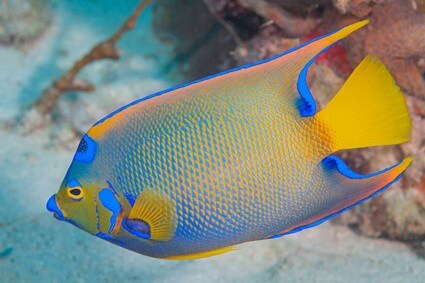
Set The pH
The ideal pH for angelfish ranges from 6.8 to 7.8. When the pH gets higher or lower than this figure, the angelfish may become stressed.
Although they can tolerate a broader range, it puts them at risk of aggression, lethargy, and illness. Use the aquarium monitoring system or pH testing strips to check the pH level.
Provide Sufficient Hiding Spots
Add more castles and rocks in the tank, so the angelfish have somewhere to hide. If you’ve just introduced new fish to the tank, move around the decorations to confuse territory lines.
That will keep established tank members from harassing newcomers. You can also add plants, driftwood, and other objects to mimic their natural habitat.
Eliminate Aggressive Fish
If you notice one of the angelfish harming or nibbling the other, don’t waste time separating them. A tank separator can prevent the aggressive fish from fighting continuously.
Add decorations or move around the territory lines by rearranging objects in the tank. If this doesn’t work, you may need to place the more aggressive fish in a tank of its own.
If the aquarium is overcrowded, consider buying a larger tank or dividing the population into two tanks.
Provide Sufficient Food
If the fish compete for food, you may need to offer more. Add some to the tank and wait for it to be eaten. Then, you can provide more until the fish go away. Anything left over can be removed with a net.
Sprinkle food across the length of the tank rather than in one spot. This ensures all fish have an equal chance to feed, rather than hoarding in one area and fighting.
If problems continue, break the meals into several feedings. You can offer smaller portions 3-4 times daily until the fish learn they needn’t compete.
Place An Oxygen Pump Inside The Aquarium
Without sufficient oxygen, the angelfish will struggle to breathe comfortably.
Consequently, they might suffocate and die. Water mixing with oxygen is continuous, and carbon dioxide constantly leaves the tank’s surface.
If you’ve covered the tank lid, the carbon dioxide will have nowhere to escape. This will result in elevated carbon dioxide levels, proving lethal for angelfish.
Air pumps are an effective way to keep the tank water oxygenated. These air pumps comprise two inlets.
One sucks in air from the outside, while the other deposits air inside the tank water. If you observe signs of suffocation in angelfish, waste no time inserting the pump.
Angelfish can be easily stressed, but it’s always for a reason. If you observe stress, evaluate the state of the tank and see where you can make adjustments.

